Introduction
As a regular cyclist who is running his daily errands almost exclusively by bike within a 10km radius in the city of Uppsala, Sweden, during all seasons, I have noticed multiple problems in the infrastructure for cyclists which makes cycling harder and more dangerous. Although some of these problems may not lead to substantial objective problems, e.g. traffic accidents or bike thefths, I would like to argue that the perceived, subjective risks has a substantial effect on deterring potential cyclists from using their bike. For example, a person who has concerns that his bike may be stolen because there is no safe bike stand at the train station may prefer not to use a bike. This may not show in any statistics, but still be barrier to increasing bike usage.
Issues and Possible Solutions
- Bike Storage at Home:
- Issues:
- It is difficult to store bikes safely at home, because apartments may not have a lockable bike storage rooms.
- Lockable bike storages maybe shared with others, which decreases the safety because it is easy for thieves to tailgate into the bike storage or otherwise get access (e.g. if door is not properly shut or locked).
- Bike stands in storage rooms are often not made of massive steel or CCTV controlled, which makes it easy to cut locks or the (hollow) pipes of soft aluminum stands.
- In addition, large bikes (e.g. cargo bikes incl. long-john, long-tail, trikes, …) , which often cost between 3 000 to 7 000 EUR, often do not fit into the stands of bike storage rooms, which makes it very risky for apartment owners to own cargo bikes because they cannot be stored safely.
- Bike stands which are narrow and only fix the front wheel may make it very difficult to lock one’s bike to a fixed point because you cannot access the stand if there are neighboring bikes. Sufficiently long bike locks may be very heavy to carry around (heavy and large) and cumbersome to use. Spiral locks may be very hard to pull to a sufficient length between frame and bike stand, especially for women and children. This often leads to cyclists only locking their front wheel to the bike stand, which makes it very easy to steal a bike.
- Possible Solution:
- The cyclist buys a cargo bike which fits into elevator and apartment, e.g. TERN Get Stuff Done (GSD) model, which can even be stored in a vertical position.
- The landlords builds dedicated, lockable, rentable bike garages. Please not that typical car garages are not suitable for large bikes because they do not feature fix points, e.g. metal bar, to lock one’s bike.
- Use motor bike locks at home to lock your bike. These locks are typically (too) heavy, e.g. around 5kg, to carry around, but maybe used at home for additional protection. The additional weight may not make a difference though for electric bikes to carry around.
- Issues:
- Bike Storage at Public Places:
- Issues:
- It is difficult to store bikes safely at public places, because bike stands are often designed to only fix the front wheel, are assembled with screws, made of soft metal (e.g. aluminum) or not massive (e.g. hollow pipes). This makes it easy for thieves to steel bikes by unscrewing a bike stand or cutting through the pipes. At occasions, I have even observed that screws of bike stands were already loose, but bike owners did not notice that and parked their bikes, but the lock could manually pulled off the bike stand.
- Bike stands which are narrow and only fix the front wheel may make it very difficult to lock one’s bike to a fixed point because you cannot access the stand if there are neighboring bikes. Sufficiently long bike locks may be very heavy to carry around (heavy and large) and cumbersome to use. Spiral locks may be very hard to pull to a sufficient length between frame and bike stand, especially for women and children. This often leads to cyclists only locking their front wheel to the bike stand, which makes it very easy to steal a bike.
- Large bike parking lots may be concentrated at certain places, which require longer walking distances to shops.
- Bike stands usually do not protect the bike from the weather, e.g. rain and snow, which makes less convenient to use a bike, e.g. because of a wet saddle.
- Possible solutions:
- Install massive bike stands under CCTV control, which serve the dual purpose of 1) effectively (e.g. organized, upright position effectively using space) and 2) safely (e.g., minimal risk of bikes being vandalized or stolen) storing bikes.
- Use a cover to hide that the hidden object is a bike, the type of bike, model and overall value.
- Having multiple smaller bike parking lots or biking stands close to shops may make biking substantially more attractive, especially for parents and kids or the elderly.
- Build bike stands with roofs.
- Issues:
- Bike Lanes:
- Issues:
- Bike lanes are too narrow for two crossing cargo bikes at typical speeds of 25km/h (relative speed difference is 50km/h!).
- Bike lanes are too narrow to allow for the highly variable speeds of cyclists, which require overtaking other bikes. The speed difference may be between 1-2 km/h (e.g. toddler on a balance bike) versus adult cyclist (e.g. 20 km/h), versus 40km/h (e.g. athlete cyclist).
- Bike lanes are often blocked by obstacles, like parked, or fallen over electric scooters (for rent).
- Possible solutions:
- Built structurally separated bike lanes, for cars, bikes and pedestrians.
- Allow bikes to use car lanes, bike lanes, or pedestrian lanes depending on speed and vulnerability (e.g. kids and seniors should be allowed to use the pedestrian lane).
- Adjust width of bike lanes for increasing size (e.g. cargo bikes) and speed (e.g. electric bikes) of bikes.
- Remove electric scooters for rent from urban areas.
- Issues:
- Traffic Barriers:
- Issues:
- Barriers may be used for residential areas, e.g. bars, concrete blocks, speed bumps, to keep out cars or reduce speed of bikes. However, these barriers make it sometimes very difficult for cyclists to use the streets, for example, if a parent with a cargo bike takes kids to school or kindergarten. Speed bumps may cause discomfort to the parent and the kid even at allowed speeds, because bikes do not have the same degree of shock absorbers as cars. Furthermore, the barriers may tempt cyclists to perform risky maneuvers to avoid the barriers or pass them without having to get off the bike. In addition, while lowering speed of bikes may increase safety of other road users, bikes become more unstable at low speeds, which increase the risk for the cyclists. Finally, reports have shown that barriers often do not increase traffic safety in general, but may instead harm safety of cyclists and, therefore, may be removed.
- Lanes for pedestrians, bike and cars, maybe separated by curbs of varying heights (1 to 20 cm), while in principle this can increase traffic safety, it should be noted that low curbs (1-5cms) may not be visible to cyclists while cycling, especially if the curb is hidden by snow, leaves or rainwater, but may substantially endanger a cyclists if he hits this obstacle unexpectedly, the front wheel gets stuck or just shifted slightly aside, making a cyclist lose his balance. It should be noted, that bike lanes typically cross curbs at crossings, while the height of curbs can vary a lot a can create unexpected risks.
- There are also bike lanes, which tilt to the outside of a curve, which may be compensated with two-wheeled bikes, but are more difficult to compensate with trikes because the cyclist cannot lean into the curve.
- Bike lanes pass by bus stops (road-side or opposite), which creates risks of collisions with pedestrians especially when rushing to catch the bus or when leaving the bus.
- Bike lanes may cross at acute angles, creating risks of being carried onto the opposite lane.
- Bike crossings may be very busy at rush hours, however, traffic is often not regulated by traffic signs or traffic lights, exposing cyclists to traffic accidents.
- Construction sites on bike lanes are often not secured to the same degree as on roads for cars regarding warning lights, alternative traffic management.
- Possible solutions:
- Remove barriers for cyclists or install barriers, which do not increase risks for cyclists, e.g. multiple flower pots with wide spaces in between requiring turns at low speed (“slalom”) may be preferable to single barriers, which require leading one’s bike through the barrier, but allow speeding to make good for the lost time.
- Remove all curbs from bike lanes, which may potentially be in the way of a cyclist.
- Adapt bike lanes, especially curves, to allow safe driving at typical speeds, by tilting them towards the centre of the curve.
- Create barriers or traffic lights around bus stops, which force pedestrians to slow down or check any crossing bike traffic.
- Issues:
- Risks by Cars:
- Issue:
- Cyclists are at risks by cars when using the road.
- Possible Solution:
- Introduce a speed limit of 30 to 40 km/h (depending on type of area) in cities to reduce the speed difference between bikes and cars (and make cycling more attractive).
- Issue:
- Risks by Bikes (see #5, bike lanes):
- Risks by Pedestrians:
- Issue:
- If the bike lane is shared with pedestrians, this increases the risk for both parties, because pedestrians often do not wear lights or reflective clothes, are often inattentive to other traffic (especially when wearing headsets or hoodies), and may not even react to acoustic warnings (e.g. bell, shouts), when wearing heads listening to music or talking on the phone.
- Bike lanes often pass by bus stops (road-side or opposite), which creates risks of collisions with pedestrians especially when rushing to catch the bus or when leaving the bus.
- Possible Solution:
- Built structurally separated bike lanes, for cars, bikes and pedestrians.
- Create barriers or traffic lights around bus stops, which force pedestrians to slow down or check any crossing bike traffic.
- Issue:
- Seasonal Barriers:
- Issue:
- Bike lanes may not be cleared of snow and ice, loose gravel, leaves, etc to the same degree as roads for cars.
- Bike lanes may be blocked by heaps of snow after clearing roads for cars.
- Possible solution:
- Considering that cyclists maybe more vulnerable to barriers on the road, bike lanes should be given special treatment to make them safe for usage by cyclists
- Issue:
References:
[1] https://www.svt.se/nyheter/lokalt/ost/rapport-farthinder-behovs-inte-for-cyklister
[2] SWECO (2016). Farthinder för cyklister – en framkomlig väg? [PDF]
Images
Image 1: Curb of walkway next to bike path hidden under snow risking the front wheel to get caught

Image 2: Curb of walkway next to bike path hidden under snow risking the front wheel to get caught

Image 3: Bike path between Gottsunda shopping centre and parking lot blocked by blocks of ice and snow, large ad board, and metal pole (in background) requiring to slalom around barriers.

Image 4: New bike path in front of Gottsunda shopping centre (on parking lot) with very high curb and bike stand facing to parking lot. This makes it very difficult to park one’s bike because one has to either lift the (heavy electric) bike over the high curb or use the ramp (in the background), but then one has to lift the bike into the bike stand because there is too little space in front of bike stand. Unusable for cargo bikes.
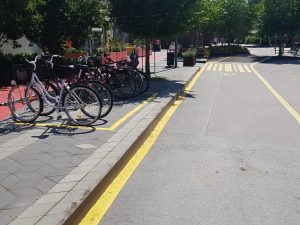
Image 5: Trees with low branches and leaves (more leaves during summer) are planted in an angle, which blocks the view to the oncoming traffic when trying to use the pedestrian crossing
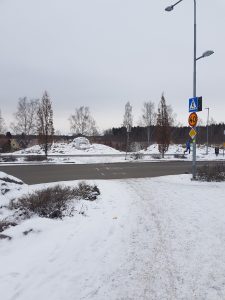
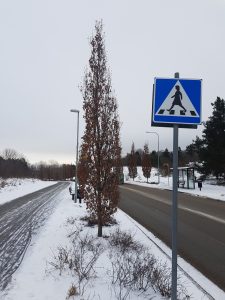
Image 6: Bike stand with narrow spaces for ergonomic bikes with broad handles risking the cables getting ripped when pulling out the bike from the stand. Very unpractical to put the bike in and out.
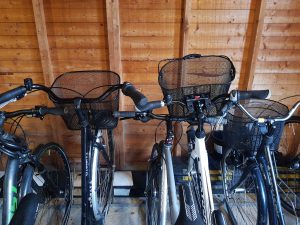
Image 7a and 7b: Barrier with metal pole and concrete blocks and additional snow and ice making it difficult to pass for cargo bike on the way to the nearby elementary school
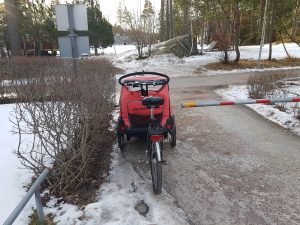
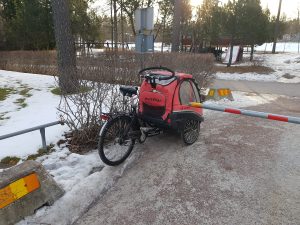
Image 8: Kid’s bike with spiral cable lock and bike stand, making it very hard for kids to lock frame to bike stand
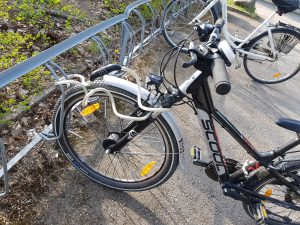
Image 9: Kid’s bikes in front of Gottsunda swimming pool and school. Bikes are only locked with front wheel to bike stand (because kids don’t have the strength to use spiral bike locks or there is too little space to use other locks properly)
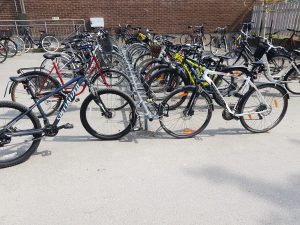
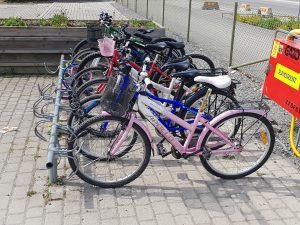
Image 10: Front wheels of stolen bikes which have been only locked to front wheel
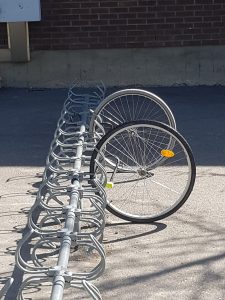
Image 11a and 11b: Bike stands are often not welded but screwed, so bike can be stolen with a screwdriver. If screws have been already remove, cyclist may lock their bikes to the bike stand unaware that their bikes are not safe
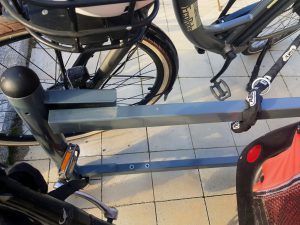

Image 12: Larger bike stands which allow locking the bike frame to the stand are often not massive but made of hollow pipes of soft aluminum which do not protect bikes sufficiently
